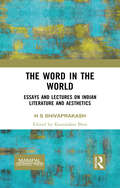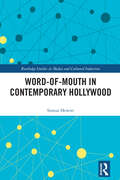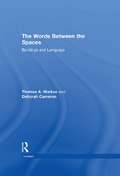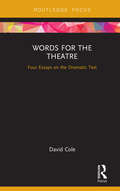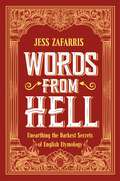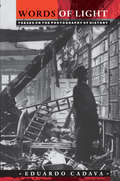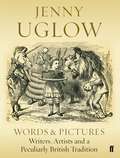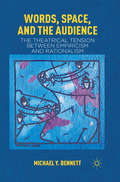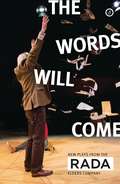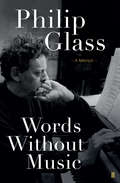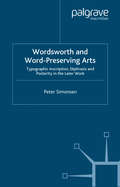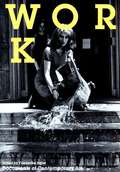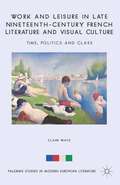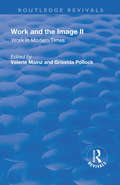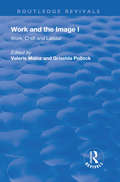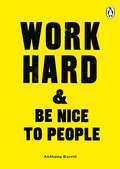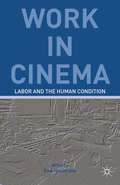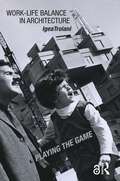- Table View
- List View
The Word in the World: Essays and Lectures on Indian Literature and Aesthetics
by H S ShivaprakashThe Word in the World is a collection of essays and lectures by H S Shivaprakash, a well-known poet, playwright, and translator. Edited by Kamalakar Bhat, this book brings together Prof Shivaprakash’s interventions in the realm of issues that are entwined with the continuities and discontinuities in the cultural negotiations of India. Distinctively, these are essays on subjects ranging from the nature and significance of medieval works of literature in India to issues arising out of developments in Indian aesthetics. The unfeigned magnitude of this work must be found among students and scholars, who will gain from it a perspective significantly different from the ones available in the prevailing academic discourses, thus indicating a way beyond poststructuralist/postmodernist frameworks. This is a book that will interest a wide variety of readers with its engaging insights and breadth of reference especially because it is written in a comprehensible style. Print edition not for sale in South Asia (India, Sri Lanka, Nepal, Bangladesh, Pakistan and Bhutan)
The Word in the World: Essays and Lectures on Indian Literature and Aesthetics
by H S ShivaprakashThe Word in the World is a collection of essays and lectures by H S Shivaprakash, a well-known poet, playwright, and translator. Edited by Kamalakar Bhat, this book brings together Prof Shivaprakash’s interventions in the realm of issues that are entwined with the continuities and discontinuities in the cultural negotiations of India. Distinctively, these are essays on subjects ranging from the nature and significance of medieval works of literature in India to issues arising out of developments in Indian aesthetics. The unfeigned magnitude of this work must be found among students and scholars, who will gain from it a perspective significantly different from the ones available in the prevailing academic discourses, thus indicating a way beyond poststructuralist/postmodernist frameworks. This is a book that will interest a wide variety of readers with its engaging insights and breadth of reference especially because it is written in a comprehensible style. Print edition not for sale in South Asia (India, Sri Lanka, Nepal, Bangladesh, Pakistan and Bhutan)
Word-of-Mouth in Contemporary Hollywood (Routledge Studies in Media and Cultural Industries)
by Simon HewittWord-of-Mouth in Contemporary Hollywood provides a unique insight into the potential for online communication to enable audiences to exert a greater impact on film industrial practices than ever before. In an overarching analysis of contemporary Hollywood film financing, marketing, distribution, and exhibition practices, Simon Hewitt recontextualises word-of-mouth in light of social media and examines the growing impact of audience participation. Using a ‘Bourdieuconomic’ approach, he applies qualitative research methods to better understand the contemporary Hollywood film audience, the contemporary Hollywood film industry, and the mechanisms that connect the two. The book explores new film financing mechanisms that incorporate fans into the packages used to secure production funds. It assesses the role of ‘Grassroots Intermediaries’ in contemporary film marketing campaigns. It critiques ‘democratic’ crowdsourced methods of film distribution, and finally, it considers the possible future of Hollywood film exhibition. By helping to bridge the gap between the gift economy and commodity culture, this book will appeal to students and scholars of media industry studies, media finance and economics, fan and audience studies, film studies, film history, and media marketing.
Word-of-Mouth in Contemporary Hollywood (Routledge Studies in Media and Cultural Industries)
by Simon HewittWord-of-Mouth in Contemporary Hollywood provides a unique insight into the potential for online communication to enable audiences to exert a greater impact on film industrial practices than ever before. In an overarching analysis of contemporary Hollywood film financing, marketing, distribution, and exhibition practices, Simon Hewitt recontextualises word-of-mouth in light of social media and examines the growing impact of audience participation. Using a ‘Bourdieuconomic’ approach, he applies qualitative research methods to better understand the contemporary Hollywood film audience, the contemporary Hollywood film industry, and the mechanisms that connect the two. The book explores new film financing mechanisms that incorporate fans into the packages used to secure production funds. It assesses the role of ‘Grassroots Intermediaries’ in contemporary film marketing campaigns. It critiques ‘democratic’ crowdsourced methods of film distribution, and finally, it considers the possible future of Hollywood film exhibition. By helping to bridge the gap between the gift economy and commodity culture, this book will appeal to students and scholars of media industry studies, media finance and economics, fan and audience studies, film studies, film history, and media marketing.
The Words Between the Spaces: Buildings and Language (Architext)
by Deborah Cameron Thomas A. MarkusUsing language - speaking and understanding it - is a defining ability of human beings, woven into all human activity. It is therefore inevitable that it should be deeply implicated in the design, production and use of buildings. Building legislation, design guides, competition and other briefs, architectural criticism, teaching and scholarly material, and the media all produce their characteristic texts.The authors use texts about such projects as Berlin's new Reichstag, Scotland's new Parliament, and the Auschwitz concentration camp museum to clarify the interaction between texts, design, critical debate and response.
The Words Between the Spaces: Buildings and Language (Architext)
by Deborah Cameron Thomas A. MarkusUsing language - speaking and understanding it - is a defining ability of human beings, woven into all human activity. It is therefore inevitable that it should be deeply implicated in the design, production and use of buildings. Building legislation, design guides, competition and other briefs, architectural criticism, teaching and scholarly material, and the media all produce their characteristic texts.The authors use texts about such projects as Berlin's new Reichstag, Scotland's new Parliament, and the Auschwitz concentration camp museum to clarify the interaction between texts, design, critical debate and response.
Words for the Theatre: Four Essays on the Dramatic Text (Focus on Dramaturgy)
by David ColeIn Words for the Theatre, playwright David Cole pursues a course of dramaturgical self-questioning on the part of a playwright, centred on the act of playwriting. The book’s four essays each offer a dramaturgical perspective on a different aspect of the playwright’s practice: How does the playwright juggle the transcriptive and prescriptive aspects of their activity? Does the ultimate performance of a playtext in fact represent something to which all writing aspires? Does the playwright’s process of withdrawing to create their text echo a similar process in the theatre more widely? Finally, how can the playwright counter theatre’s pervasive leaning towards the ‘mistake’ of realism? Suited to playwrights, teachers, and higher-level students, this volume of essays offers reflections on the questions that confront every playwright, from an author well-versed in supplying words for the theatre.
Words for the Theatre: Four Essays on the Dramatic Text (Focus on Dramaturgy)
by David ColeIn Words for the Theatre, playwright David Cole pursues a course of dramaturgical self-questioning on the part of a playwright, centred on the act of playwriting. The book’s four essays each offer a dramaturgical perspective on a different aspect of the playwright’s practice: How does the playwright juggle the transcriptive and prescriptive aspects of their activity? Does the ultimate performance of a playtext in fact represent something to which all writing aspires? Does the playwright’s process of withdrawing to create their text echo a similar process in the theatre more widely? Finally, how can the playwright counter theatre’s pervasive leaning towards the ‘mistake’ of realism? Suited to playwrights, teachers, and higher-level students, this volume of essays offers reflections on the questions that confront every playwright, from an author well-versed in supplying words for the theatre.
Words from Hell: Unearthing the Darkest Secrets of English Etymology
by Jess ZafarrisThe English language is where words go to be tortured and mutilated into unrecognizable shadows of their former selves. It's where Latin, Greek, and Germanic roots are shredded apart and stitched unceremoniously back together with misunderstood snippets of languages snatched from the wreckage of conquest and colonialism. It wreaks merciless havoc upon grammar and spelling. It turns clinical terms into insults and children's tales into filthy euphemisms.With an emphasis on understanding where the foulest words in the English language came from-and the disgusting and hilarious histories behind them-this book demonstrates the true filth of our everyday words. But this book is more than just a list of vulgar words and salacious slang. It's a thoughtful analysis of why we deem words as being inappropriate as well as revealing 'good words' that have surprisingly naughty origins.Dirty-minded word nerds and lewd linguistics lovers will derive unadulterated pleasure in leering at the origins of swear words, sexual lingo, inappropriate idioms, violent vocabulary, and terminology for bodily functions-not to mention the unexpectedly foul origins of words you thought were perfectly innocent. If it's inappropriate, stomach-churning, uncomfortable, or offensive, this book reaches into the dark recesses of history and exposes them for all to see.True to the Chambers brand, this book combines humour, scholarly research and a beautiful design. It is a book to enjoy, collect and revisit time and time again.
Words of Light: Theses on the Photography of History (PDF)
by Eduardo CadavaHere Eduardo Cadava demonstrates that Walter Benjamin articulates his conception of history through the language of photography. Focusing on Benjamin's discussions of the flashes and images of history, he argues that the questions raised by this link between photography and history touch on issues that belong to the entire trajectory of his writings: the historical and political consequences of technology, the relation between reproduction and mimesis, images and history, remembering and forgetting, allegory and mourning, and visual and linguistic representation. The book establishes the photographic constellation of motifs and themes around which Benjamin organizes his texts and thereby becomes a lens through which we can begin to view his analysis of the convergence between the new technological media and a revolutionary concept of historical action and understanding. Written in the form of theses--what Cadava calls "snapshots in prose"--the book memorializes Benjamin's own thetic method of writing. It enacts a mode of conceiving history that is neither linear nor successive, but rather discontinuous--constructed from what Benjamin calls "dialectical images." In this way, it not only suggests the essential rapport between the fragmentary form of Benjamin's writing and his effort to write a history of modernity but it also skillfully clarifies the relation between Benjamin and his contemporaries, the relation between fascism and aesthetic ideology. It gives us the most complete picture to date of Benjamin's reflections on history.
Words & Pictures: Writers, Artists and a Peculiarly British Tradition
by Jenny UglowWords & Pictures explores three fascinating examples of relationships between artists and writers: the illustrations of Paradise Lost and Pilgrim's Progress; Hogarth and Fielding, a writer and artist dealing with common material; Wordsworth and Thomas Bewick, a poet and engraver working separately, but imbued with the spirit of their age. A brief coda turns to a fourth kind of relationship, the writers and artists who collaborate from the start, beginning with Dickens and Phiz. Illustrated throughout with a wide variety of examples, this is a book to pore over and enjoy. At turns moving and comic, this book illuminates a brilliant poet, an engraver, a writer and an artist, it touches on a peculiarly British tradition of community and defiance of authority, unmasking pretension and celebrating energy and warmth. The visions it considers link daily life to the universal, the passionate and the sublime. Jenny Uglow is the award-winning author of Elizabeth Gaskell (winner of the Portico Prize), Nature's Engraver, which won the National Arts Writers Award, and A Gambling Man, which was shortlisted for the 2010 Samuel Johnson Prize and most recently In These Times. 'Perhaps future biographies (of requisite quality) celebrating a certain kind of unshowy Georgian figure could be called "Uglow's Lives" after the woman who has made the genre her own.' Sunday Telegraph
Words, Space, and the Audience: The Theatrical Tension between Empiricism and Rationalism
by M. BennettIn this unique study, Michael Y. Bennett re-reads four influential modern plays alongside their contemporary debates between rationalism and empiricism to show how these monumental achievements were thoroughly a product of their time, but also universal in their epistemological quest to understand the world through a rational and/or empirical model. Bennett contends that these plays directly engage in their contemporary epistemological debates rather than through the lens of a specific philosophy. Besides producing new, insightful readings of heavily-studied plays, the interdisciplinary (historical, philosophical, dramatic, theatrical, and literary) frame Bennett constructs allows him to investigate one of the most fundamental questions of the theatre - how does meaning get made? Bennett suggests that the key to unlocking theatrical meaning is exploring the tension between empirical and rational modes of understanding. The book concludes with an interview with performance artist Coco Fusco.
The Words Will Come: New Plays From The Rada Elders Company (Oberon Modern Playwrights)
by Nell Leyshon Christopher William Hill Deborah Bruce A. C. Smith Frances PoetBringing together five plays commissioned specially for the RADA Elders Company, this anthology provides a selection of dynamic and thought-provoking works for Elders companies anywhere. The RADA Elders Company began in 2013 in order to provide opportunities for older people to experience the academy’s training at its best. Each year, a playwright is invited to create a new piece for the company, encompassing a wide range of theatre disciplines and skills. FEATURINGBroken Pieces by A. C. SmithOur Father by Deborah BruceThe Word by Nell LeyshonDown the Hatch by Frances PoetOf Blood by Christopher William Hill
Words Without Music: A Memoir
by Philip GlassRapturous in its ability to depict the creative process, Words Without Music allows readers to experience that sublime moment of creative fusion when life merges with art. Biography lovers will be inspired by the story of a precocious Baltimore boy, the son of a music-shop owner, who entered college at age fifteen, before traveling to Paris to study under the legendary Nadia Boulanger; Glass devotees will be fascinated by the stories behind Einstein on the Beach and Satyagraha, among so many other works. Whether recalling his experiences working at Bethlehem Steel, traveling in India, driving a cab in 1970s New York, or his professional collaborations with the likes of Allen Ginsberg, Ravi Shankar, Robert Wilson, Doris Lessing, and Martin Scorsese, Words Without Music affirms the power of music to change the world.
Wordsworth and Word-Preserving Arts: Typographic Inscription, Ekphrasis and Posterity in the Later Work
by P. SimonsenBy looking at the later Wordsworth's ekphrastic writings about visual art and his increased awareness of the printed dimension of his work, Simonsen calls attention to what is uniquely exciting about this neglected body of work, and argues that it complicates traditional understandings of Wordsworth based on his so-called Great Decade.
Work: Documents of Contemporary Art
by Friederike SiglerPart of the acclaimed series of anthologies which document major themes and ideas in contemporary art. Contextualises a recent focus on the subject of work in art, addressing work's meaning both within art and in its wider economic and social context.
Work and Leisure in Late Nineteenth-Century French Literature and Visual Culture: Time, Politics and Class (Palgrave Studies in Modern European Literature)
by C. WhiteIn this engaging new study, Claire White reveals how representations of work and leisure became the vehicle for anxieties and fantasies about class and alienation, affecting, in turn, the ways in which writers and artists understood their own cultural work.
Work and the Image: Volume 2: Work in Modern Times - Visual Mediations and Social Processes
by Valerie Mainz Griselda PollockThis title was first published in 2000. Published in two volumes, "Work and the Image" addresses a critical theme in contemporary social and cultural debates whose place in visual representation has been neglected. Ranging from Greek pottery to contemporary performance, and exploring a breadth of geo-national perspectives including those of France, Britain, Hungary, Soviet Russia, the Ukraine, Siberia and Germany, the essays provide a challenging reconsideration of the image of work, the meaning of the work process, and the complex issues around artistic activity as itself a form of work even as it offers a representation of labour. With a shared focus on the 20th century, the era of modernity and its postmodern aftermath, the essays in this volume examine the diverse ways in which the social relations of work in industrial societies from both capitalist and socialist regimes were publicly and privately mediated by changing forms of visual representation. The authors discuss traditional analyses of the image of the worker in the light of contemporary critical theories that address the question of the subjectivity of the worker in relation to class, gender, nationhood and the concept of modernity.
Work and the Image: Volume 2: Work in Modern Times - Visual Mediations and Social Processes
by Valerie Mainz Griselda PollockThis title was first published in 2000. Published in two volumes, "Work and the Image" addresses a critical theme in contemporary social and cultural debates whose place in visual representation has been neglected. Ranging from Greek pottery to contemporary performance, and exploring a breadth of geo-national perspectives including those of France, Britain, Hungary, Soviet Russia, the Ukraine, Siberia and Germany, the essays provide a challenging reconsideration of the image of work, the meaning of the work process, and the complex issues around artistic activity as itself a form of work even as it offers a representation of labour. With a shared focus on the 20th century, the era of modernity and its postmodern aftermath, the essays in this volume examine the diverse ways in which the social relations of work in industrial societies from both capitalist and socialist regimes were publicly and privately mediated by changing forms of visual representation. The authors discuss traditional analyses of the image of the worker in the light of contemporary critical theories that address the question of the subjectivity of the worker in relation to class, gender, nationhood and the concept of modernity.
Work and the Image: Volume 1: Work, Craft and Labour - Visual Representations in Changing Histories
by Valerie Mainz Griselda PollockThis title was first published in 2000. "Work and the Image", published in two volumes, addresses a critical theme in contemporary social and cultural debates whose place in visual representation has been neglected. Ranging from Greek pottery to contemporary performance, and exploring a breadth of geo-national perspectives including those of France, Britain, Hungary, Soviet Russia, the Ukraine, Siberia and Germany, the essays provide a challenging reconsideration of the image of work, the meaning of the work process, and the complex issues around artistic activity as itself a form of work even as it offers a representation of labour. Volume I includes interdisciplinary case studies which plot the changing definitions of work as labour, craft, social relations and a source of historical identity, while analyzing the role of visual representation in their formation and transformation. The diverse essays cover such topics as anti-slavery movements and enunciation of workers' rights, revolutionary politics, relations of class and gender, industrial masculinities and women's rural sociality, unemployment and subjectivity, Stalinist aesthetics and nationalist identities.
Work and the Image: Volume 1: Work, Craft and Labour - Visual Representations in Changing Histories
by Valerie Mainz Griselda PollockThis title was first published in 2000. "Work and the Image", published in two volumes, addresses a critical theme in contemporary social and cultural debates whose place in visual representation has been neglected. Ranging from Greek pottery to contemporary performance, and exploring a breadth of geo-national perspectives including those of France, Britain, Hungary, Soviet Russia, the Ukraine, Siberia and Germany, the essays provide a challenging reconsideration of the image of work, the meaning of the work process, and the complex issues around artistic activity as itself a form of work even as it offers a representation of labour. Volume I includes interdisciplinary case studies which plot the changing definitions of work as labour, craft, social relations and a source of historical identity, while analyzing the role of visual representation in their formation and transformation. The diverse essays cover such topics as anti-slavery movements and enunciation of workers' rights, revolutionary politics, relations of class and gender, industrial masculinities and women's rural sociality, unemployment and subjectivity, Stalinist aesthetics and nationalist identities.
Work Hard & Be Nice to People
by Anthony BurrillAsk More Questions, Get More AnswersDon’t Be Normal, Don’t Be OrdinarySay Yes More Than No!Work Hard & Be Nice to PeopleIt’s usually the simple truths that provide the most profound answers. Discover inspirational aphorisms and sound advice for the real world from graphic artist Anthony Burrill, inspired by his best-loved and most iconic typographic prints. With wise words on getting things done, success, creativity, difficult decisions, motivation, work, collaboration and happiness, this refreshing, life-affirming guide is the perfect gift or ‘manual for all those needing a little inspired encouragement.’ WallpaperWork Hard & Be Nice to People is a re-worked and re-packaged paperback edition of Make it Now! with some new material.
Work in Cinema: Labor and the Human Condition
by E. KerrCinema frequently depicts various types of work, but this representation is never straightforward. It depends on and reflects many factors, especially the place and time the film is made and the type of audience it addresses. Here, the contributors employ transnational and transhistorical perspectives to compare filmic depictions of work.
Work-Life Balance in Architecture: Playing the Game
by Igea TroianiThis book seeks to improve the work lives of architects of diverse demographics who do not fit, or want to replicate, the traditional ‘24/7’ white-male architect lifestyle. Aimed at a workforce whose life and career expectations have changed drastically in recent years, it helps readers of different generations to make informed choices about their careers – enabling students, educators, and professionals to prioritise wellbeing and offer their design and practice voice to enhance a built environment for all.Work-Life Balance in Architecture examines what it means to play the ‘game of architecture’ – to choose to study and pursue a career in architecture rather than another profession. The book shows the economic, social, and professional structures within which architectural education and practice operate and reveals the impact of a corporate, neoliberal ‘big business’ mentality on wellbeing.After setting out the context exacerbating work-life imbalance, the book discusses the paths an architect may take – whether this leads to a career in practice or not in architecture at all – and how alternative gameplay moves can advantage or disadvantage those of different gender, class, ethnicity, race, or age at different career stages. It concludes by examining how the places in which an architect works, the time available to work and critiques of perpetual neoliberal economic growth can enhance the lives of all architects today.
Work-Life Balance in Architecture: Playing the Game
by Igea TroianiThis book seeks to improve the work lives of architects of diverse demographics who do not fit, or want to replicate, the traditional ‘24/7’ white-male architect lifestyle. Aimed at a workforce whose life and career expectations have changed drastically in recent years, it helps readers of different generations to make informed choices about their careers – enabling students, educators, and professionals to prioritise wellbeing and offer their design and practice voice to enhance a built environment for all.Work-Life Balance in Architecture examines what it means to play the ‘game of architecture’ – to choose to study and pursue a career in architecture rather than another profession. The book shows the economic, social, and professional structures within which architectural education and practice operate and reveals the impact of a corporate, neoliberal ‘big business’ mentality on wellbeing.After setting out the context exacerbating work-life imbalance, the book discusses the paths an architect may take – whether this leads to a career in practice or not in architecture at all – and how alternative gameplay moves can advantage or disadvantage those of different gender, class, ethnicity, race, or age at different career stages. It concludes by examining how the places in which an architect works, the time available to work and critiques of perpetual neoliberal economic growth can enhance the lives of all architects today.
